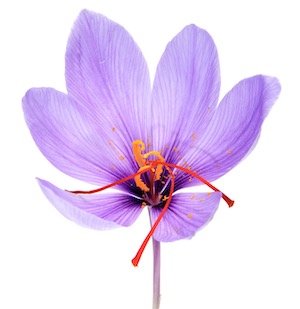In France, it gives bouillabaisse that added touch. In India, it enriches curries. And in Italy, just a pinch makes for a perfect risotto. Saffron, the “24 carat gold of spices,” comes from the tiny red-orange stigmas of the Crocus sativus. Over the centuries, these prized filaments have been added to magic potions, medicines, cosmetics and food. Cleopatra, the Queen of the Nile, was known to include in her bathwater. Carefully handpicked, each crocus bloom provides just three fragile strands of the exotic spice. It requires around 150 flowers to produce 1 gram of saffron, explaining why it's the most expensive spice known to man – fetching upwards of $10,000 per kilogram. Saffron smells earthy, like mown grass, and tastes both bitter and sweet. Some say it is similar to floral honey.
Crocus flowers are grown in Afghanistan, Greece, India, Iran, Italy, Morocco, and Spain. The flower’s petals are a rich lilac purple, contrasting nicely with the brilliant orange stigmas. The harvesting occurs in the fall, when the flowers only bloom for 3-14 days. Flower heads get plucked from the plant and the stigmas are removed, dried and sorted. Colour, age, flexibility and the amount of non-stigma content determine the quality of saffron. Due to the high prices saffron commands, some spice traders have altered the colour to increase its appeal. So be sure to inspect your saffron closely before purchasing.
According to Hindu mythology, saffron is considered a sacred colour. Saffron (or Kesariya) is the colour of Sunset and Fire – symbolizing sacrifice, light, and a quest for salvation. No wonder people are attracted to the warm, passionate tones of saffron – from its rich yellows to intense oranges to lively reds.

